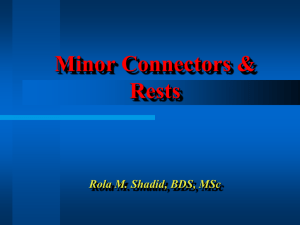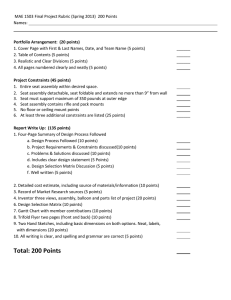Document 12822779
advertisement
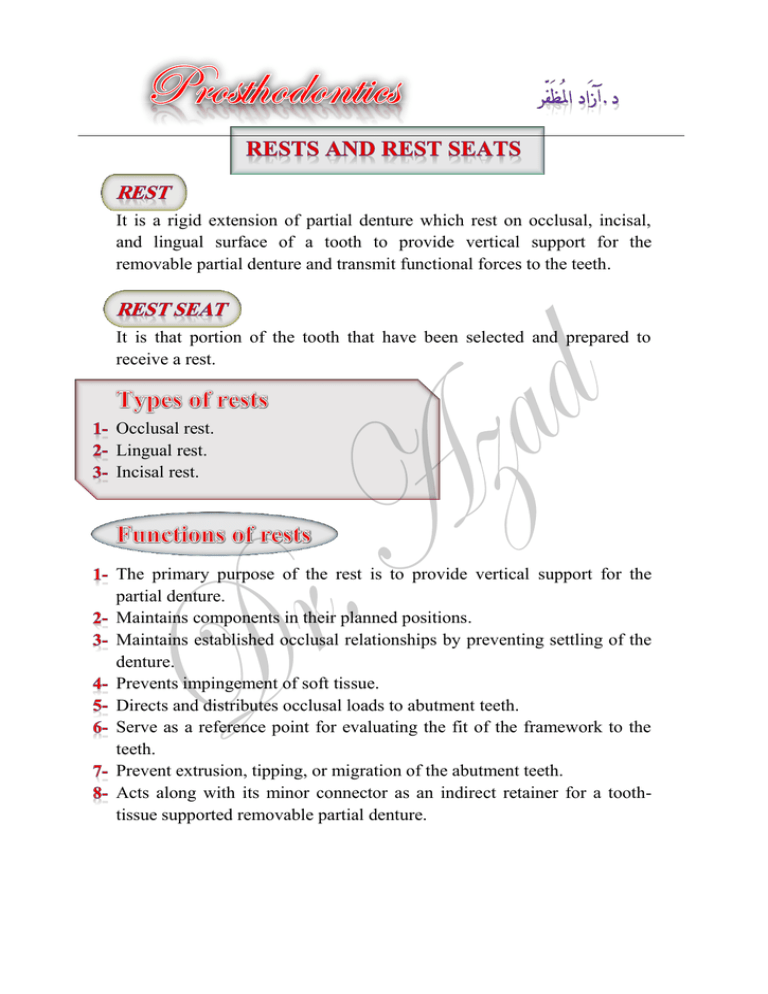
It is a rigid extension of partial denture which rest on occlusal, incisal, and lingual surface of a tooth to provide vertical support for the removable partial denture and transmit functional forces to the teeth. It is that portion of the tooth that have been selected and prepared to receive a rest. Occlusal rest. Lingual rest. Incisal rest. The primary purpose of the rest is to provide vertical support for the partial denture. Maintains components in their planned positions. Maintains established occlusal relationships by preventing settling of the denture. Prevents impingement of soft tissue. Directs and distributes occlusal loads to abutment teeth. Serve as a reference point for evaluating the fit of the framework to the teeth. Prevent extrusion, tipping, or migration of the abutment teeth. Acts along with its minor connector as an indirect retainer for a toothtissue supported removable partial denture. 1234- There are several points which should be put into consideration in determination of the site and form of the rests. Root form. Root length. Inclination of the tooth. Ratio of the length of the clinical crown to the alveolar support. 1- The outline form of an occlusal rest seat should be a rounded triangular shape with the apex toward the center of the occlusal surface. 2- It should be as long as it is wide, and the base of the triangular shape (at the marginal ridge) should be at least 2.5 mm for both molars and premolars. Rest seats of smaller dimensions do not provide an adequate bulk of metal for rests. 3- The marginal ridge of the abutment tooth at the site of the rest seat must be lowered to permit a sufficient bulk of metal for strength and rigidity of the rest and the minor connector. This means that a reduction of the marginal ridge of approximately 1.5 mm is usually necessary. 4- The floor of the occlusal rest seat should be apical to the marginal ridge and the occlusal surface and should be concave, or spoon shaped. Caution should be exercised in preparing a rest seat to avoid creating sharp edges or line angles in the preparation. 5- The angle formed by the occlusal rest and the vertical minor connector from which it originates should be less than 90°. Only in this way can the occlusal forces be directed along the long axis of the abutment tooth. An angle greater than 90° fails to transmit occlusal forces along the supporting vertical axis of the abutment tooth. This also permits slippage of the prosthesis away from the abutment, which can result in orthodontic-like forces being applied to an inclined plane on the abutment, with possible tooth movement, so a secondary rest is placed on the opposite side of an abutment to prevent slippage of the rest. Interproximal rests (embrasure rest): One or two occlusal rests on adjacent teeth; every seat must be prepared as an individual occlusal rest with exception that the preparation must be more lingually. Although the preferred site for an external rest is the occlusal surface of a molar or a premolar, also anterior teeth occasionally must be used to support an indirect retainer or an auxiliary rest. A canine is much preferred over an incisor for this purpose. When a canine is not present, multiple rests that are spread over several incisor teeth are preferable to the use of a single incisor. A lingual rest is preferable to an incisal rest. The rest seat, from lingual aspect, form of a broad inverted V- notch form is self-centering for the rest and at the same time directs forces rather favorably in an apical direction. Looking at preparation from incisal view, it will be noted that rest seat preparation is broadest at most lingual aspect of canine. As preparation approaches proximal surfaces of tooth, it is less broad than at any other areas. Proximal view demonstrates correct taper of floor of rest seat. It also should be noted that borders of rest seat are slightly rounded to avoid line angles in its preparation. Mesiodistal length of preparation should be a minimum of 2.5-3 mm, labiolingual width about 2 mm, and incisoapical depth a minimum of 1.5 mm. A slightly rounded V is prepared on the lingual surface at the junction of the gingival and the middle one third of the tooth. The apex of the V is directed incisally. All line angles must be eliminated, and the rest seat must be prepared within the enamel and must be highly polished. A predetermined path of placement for the denture must be kept in mind in preparing the rest seat. Incisal rests are placed at the incisal angles of anterior teeth and on prepared rest seats. Although this is the least desirable placement of a rest seat for reasons previously mentioned, it may be used successfully for selected patients when the abutment is sound. It is prepared in the form of a rounded notch at the incisal angle or on an incisal edge; the floor of rest seat has been extended slightly onto labial aspect of tooth. Lingual view shows that all borders of rest seat are rounded to avoid sharp line angles. It is especially important to avoid a line angle at junction of axial wall of preparation and floor of rest seat. Lingual rest is more esthetic than the incisal rest because it lies on the lingual surface completely. Lingual rest usually placed nearer to the horizontal axis of rotation of the abutment tooth (tipping axis), so it will has fewer tendencies to tip the teeth. For mandibular teeth, they are not involved in the occlusion.

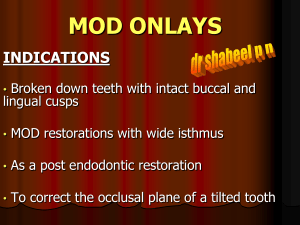
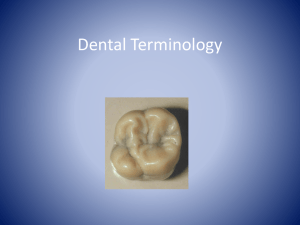
![introduction [ppt]](http://s2.studylib.net/store/data/010246435_1-1af68ba70284a99754c8448728f5e3e9-300x300.png)
